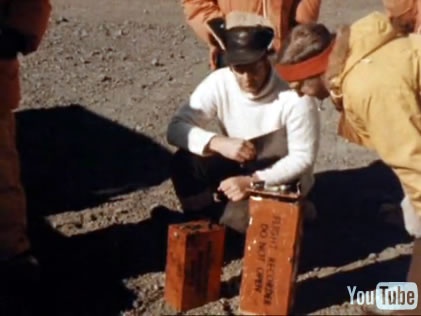
The two flight recorders shortly after they were recovered from the crash site.
Site investigation begins
On the afternoon of 2 December 1979, Colin Fink and Peter Hall, surveyors stationed at Scott Base, were flown to the crash site, accompanied by members of the accident investigation team and their mountaineer assistants. David Graham, an air accident investigator from the Office of Air Accidents, and Ian Wood and Captain Ian Gemmell from Air New Zealand, made up the investigation team. Ron Chippindale, the chief air accident investigator, worked at the site over the following days. However, he spent most of his time at Scott Base and at McMurdo Station, where he interviewed staff at Mac Center, the US Navy's air traffic control centre at McMurdo Station, the 'Ice Tower' at nearby Williams Field, and US Navy pilots who had flown in the area on the day of the crash.
24 hours of light
During summer Antarctica experiences 24 hours of daylight, so the site investigation and recovery operation could continue at any hour so long as the weather held.
As the surveyors began to survey the site and lay out a grid system and a helipad, the investigators began searching the wreckage. The parties were assisted by Keith Woodford, Hugh Logan and Daryl Thompson, and three other mountaineers from the Face Rescue Squad. The priority was to find the CVR (Cockpit Voice Recorder) and the DFDR (Digital Flight Data Recorder). Within a few hours these were located by Gemmell and a mountaineer from the Face Rescue Squad. The weather closed in again, but as soon as it cleared on the morning of 3 December the recorders were flown back to McMurdo.
Reinforcements
The break in the weather allowed another flight from New Zealand to land. This carried American experts representing the National Transportation Safety Board (NTSB), the Federal Aviation Authority, and the aircraft and engine manufacturers McDonnell Douglas Corporation and General Electric Operations. They were accompanied by a further air investigator, Milton Wylie, and another representative of the NZ Airline Pilots Association, Captain Anthony (Tony) Foley. They would assist with the investigation both on and off the crash site.
Within five hours Wylie and Dennis Grossi from the NTSB were on their way back to New Zealand and then the United States with the CVR and DFDR. Cabinet minister Bill Birch, who had flown to Antarctica with the first recovery and investigation parties, also returned on this flight and reported that the recovery effort was ‘in the hands of the weather’.
Work continued at the crash site. The helipad was constructed and bodies were marked with green flags amid fears that they might be covered by snow.
Part of: Operation Overdue
Next page: Recovery operation begins

Community contributions